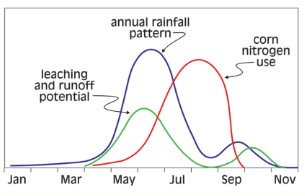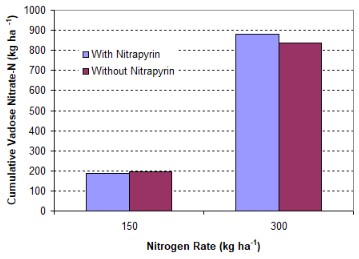By Charles Wortmann, Laila Puntel
The leaching of nitrate to groundwater and the increasing occurrence of groundwater with excessive nitrate levels for human consumption are of major concern in Nebraska. The amount of leached NO3- depends on soil NO3- concentration at different soil depth layers and the quantity of water movement downward through these soil layers to beyond the root zone. Nitrate-N leaching is not like flushing a toilet! It is a gradual downward movement with adjustments in the nitrate concentration of soil water as it percolates through many soil layers. Most leaching is expected to occur from late April to June (Figure 1). This article provides a practical condensation of information from numerous research works and Extension publications to offer management options for reduced leaching loss of nitrate (NO3-) to the vadose zone and eventually to the aquifer (Figure 2). Nine agronomic management opportunities for reduced NO3- leaching are addressed, most with little or no cost and often with reduced ammonia volatilization and nitrous oxide (N2O) emission to the atmosphere.

Figure 1. An illustration of the potential nitrogen loss to leaching and runoff relative to rainfall and crop N uptake.
Avoid excessive water
A full-season fully irrigated corn crop uses about 26” of water including stored soil water, rainfall and irrigation water. More water may be required if significant losses to soil evaporation and deep percolation occur. Deep percolation in the spring before the crop has a high rate of water use is often unavoidable, especially for sandier soils in Nebraska. While such deep percolation often contributes eventually to aquifer recharge, it also carries NO3- to groundwater. Deep percolation can be reduced by judiciously scheduled irrigation and depletion of soil water as the crop matures to allow for the soil storage of precipitation. Soil NO3- concentrations can be reduced by practices addressed below.
Cropping system
Previous crop
Fertilizer-N recovery (defined as the increase in pounds of N uptake by the above-ground crop per pound of fertilizer-N applied) is greater for the corn-soybean rotation than for continuous corn. The greater recovery with the rotation is due to better N recovery efficiency by corn with soybean rather than corn as the previous crop, but also because soybean on average gets about 55-70% of its plant N from the biological fixation of atmospheric N and effectively scavenges soil inorganic N to meet the balance of N need.
The average amount of grain-N removed in harvest for Nebraska is about 0.7 lb/lb of fertilizer-N applied for continuous corn but near 1.0 lb/lb for the corn-soybean rotation. The amount of N applied with the corn-soybean rotation is about 40% of that applied with continuous corn. The greater recovery efficiency and the greatly reduced fertilizer-N applied is expected to reduce NO3-1 loading of the vadose zone (the depth from the rooting zone to the top of the water saturate aquifer) and movement to groundwater. In a 20-year study in Nebraska, nitrate accumulated to 60 foot depth was 28% less with the corn-soybean rotation compared with continuous corn but this was an underestimate due to over-irrigation of soybean and over-application of N to corn following soybean; a 40-50% reduction in NO3- leaching is more likely.
Alfalfa in rotation
The value of alfalfa in rotation with annual crops for reducing NO3- leaching loss has been recognized for decades. In addition to alfalfa uptake of inorganic N to about 10-12 foot depth and using NO3- applied in irrigation water, the fertilizer-N required for such a rotation with alfalfa is about 45% of that required by the corn-soybean rotation. The profitability of having 5 years of alfalfa rotated with 5 years of corn-soybean rotation may be greater than with corn-soybean rotation. In Iowa, having alfalfa in the rotation for 50% of the years is credited with 42% less nitrate loss to tile drainage compared with the corn-soybean rotation. Alfalfa in the rotation appears to be especially worthy of consideration for community well-head protection areas.
Double cropping
Producing a cover crop or an annual forage crop, whether grazed or cut for harvest, increases residual inorganic N uptake relative to the growth achieved. The N uptake may be 25-30 lb per 1000 lb of dry matter, depending on growth stage and species. The uptake will be primarily from the 0-12 in depth while deeper nitrate is most prone to leaching below the rooting depth of the primary crop. The plant N will not be fully available to the following primary crop; some proportion of cover crop N is likely to be available for later growth of the primary crop with additional plant N mineralized after N uptake by the main crop has ceased. As a result, additional fertilizer N is often needed to maintain yield following such a cover or forage crop. Early immobilization of N is less with legume than with non-legume cover crops due to relatively high N content. For grazed fields, the excreted-N that is not lost to the volatilization of ammonia will soon be available for uptake by crops and soil microbes. The double cropping effects on NO3- accumulation in the vadose are yet to be validated but greater effects are expected as soil sand content increases. Winter rye cover crop is credited in Iowa for reduced NO3- loss in tile drainage.
Nitrification inhibitors and special N-fertilizers
Products that delay the conversion of fertilizer-N to highly mobile NO3- have been available since the 1960s and have been extensively studied. Much information is readily available. Such products, if well-targeted and used in a timely manner, can have a modest role in reduced leaching of NO3- from fertilizer-N, but not from residual soil NO3-, with sandy loam or sandier soil. The greatest NO3- leaching potential for most fields in Nebraska is in May and early June although the potential is great for sandy soil throughout the year. The use of nitrification inhibitors or N fertilizer products needs to be timed to minimize nitrification of fertilizer-N before and during the time of high leaching potential such as with application in April to June. The use of nitrification inhibitors was not effective in reducing leaching for a silt loam soil in Nebraska during 20 years of continuous irrigated corn while the application of excessive fertilizer-N had a great effect (Figure 3). The results indicate little potential for use of nitrification inhibitors to reduce NO3- leaching to the vadose for silt loam, silty clay loam and finer texture soils, likely due to relatively little water percolating below the root zone compared with sandier soils. Use of a nitrification inhibitor with late fall-applied anhydrous ammonia may reduce NO3- leaching to the vadose, especially if the field has some sandy loam or sandy soil, and have resulted in some yield increases for eastern Corn Belt states. Use of an inhibitor with fall applied anhydrous ammonia is credited with a 7% reduction in nitrate loss to tile drainage in Iowa, while inhibitor use with spring application is not part of their strategy. The loss of nitrate to tile drainage in Iowa was 6% greater with fall compared with spring N application and 4% less with in-season application compared with pre-plant application. Some reduction in NO3- leaching is expected in Nebraska with inhibitor use for fertilizer-N applied to sandy loam or sandier soil in the spring before June 1. Overall, nitrification inhibitor use should be well-targeted and only a small part of strategies to reduce NO3-1 leaching.

Click here to see more...